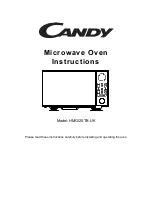
20
GENERAL INFORMATION
➪
Put the food on a microwave rack (roasts, bone-in pieces) or in a microwave casserole (small pieces such
as cubes or strips) or weigh at home on a kitchen scale. Round number to the nearest tenth of a pound
and choose that number with each item pads.
➪
The shape of food items, especially larger ones, will vary affect the way defrost. Always check the status
after the standing time. Fish, seafood and poultry should still be somewhat icy in the center the held under
cold running water to finish defrosting. If more time is needed, use DEFROST by time to add time in small
increments.
➪
Halfway through the defrosting process, a series of beeps will indicate that it is time to change the position
of the item being defrosted. The includes turning over or rotating the item, separating defrosted pieces or
sections, or shielding.
➪
Shielding means to use a 2-inch strip of aluminum foil to protect thinner or unevenly shaped part from
beginning to cook. Microwave energy will not penetrate the foil. Some rules apply to the use of foil:
Do not let the foil pieces touch each other or the sides of the microwave oven.
Be sure that all ends are touched under and lie flat to the food.
Remember to adjust foil when a item is turned over and cover with wax paper.
➪
To prepare food for freezer storage(and later defrosting), wrap tightly in moisture proof packaging.
If using freezer plastic bags, be sure to let all the air out to prevent freezer bump on the food.
Package so that food is as evenly shaped as possible ease in defrosting.
DEFROSTING GUIDE








































